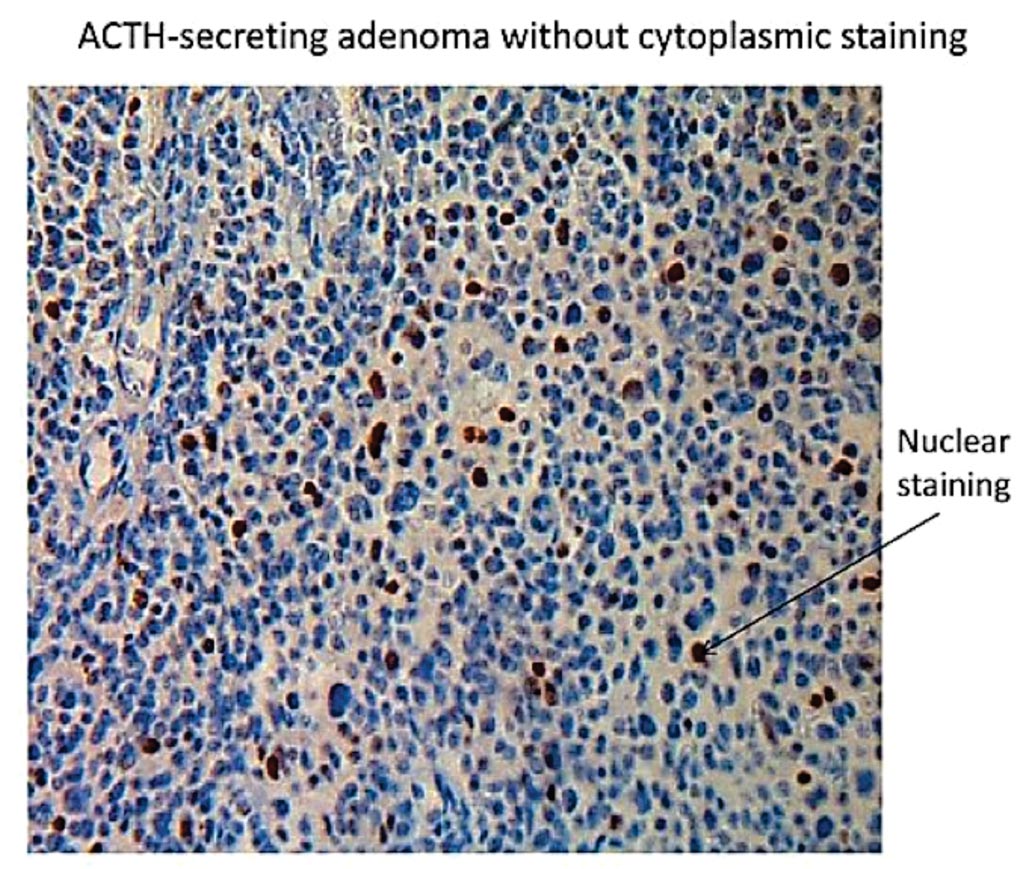Diagnostic Options When Standard Tests Are Inconclusive
By LabMedica International staff writers
Posted on 18 Oct 2017
The diagnosis of Cushing’s disease, the predominant endogenous form of Cushing’s syndrome, requires a laboratory strategy that sequentially rules out potential causes of excess cortisol until the correct one is identified.Posted on 18 Oct 2017
After ruling out exogenous causes of Cushing’s-like symptoms, the first step is to document cortisol excess. Blood cortisol concentration exhibits diurnal variation, so it is less useful than 24-hour urinary free cortisol, which the Endocrine Society (Washington, DC, USA) recommends for demonstrating overproduction of the hormone.

Image: Immunostaining for nuclear p21 on a pituitary tumor. ACTH-secreting adenoma without cytoplasmic staining (Photo courtesy of the William Harvey Research Institute).
The other two recommended screening tests are salivary cortisol and the 1 mg overnight dexamethasone suppression test. If two of these three screening tests are abnormal, further investigation should be undertaken. If elevated adrenocorticotropic hormone (ACTH) is detected, this suggests an ACTH-dependent form of Cushing’s syndrome. About 30% of Cushing’s syndrome cases are ACTH-independent, but among ACTH-dependent cases, nearly all are caused by an ACTH-secreting pituitary adenoma and classified as Cushing’s disease. The remainder of ACTH-dependent cases is due to ectopic ACTH producing tumors, which are very rare and usually occur in the lungs or thymus, although they have also been described in the thyroid, ovaries, liver, and adrenal glands.
A high-dose dexamethasone suppression test helps determine if the case is Cushing’s disease or caused by ectopic ACTH production. High doses of dexamethasone often suppress ACTH production by pituitary adenomas, whereas no suppression occurs in ectopic tumors. Stimulation with corticotropin releasing hormone (CRH) also tends to exaggerate ACTH release in Cushing’s disease, whereas ectopic tumors respond poorly or not at all. In a small fraction of cases, however, the results of all of these tests are non-diagnostic. When this occurs, bilateral inferior petrosal sinus sampling (BIPSS) is needed to verify that the source of ACTH is the pituitary gland.
It has been reported that in patients with an ectopic ACTH producing tumor, the ratio of IPS: venous ACTH concentrations will be less than 1.4:1. In patients with Cushing’s disease, the ratio will exceed 2.0, with averages near 15. The sensitivity and specificity of BIPSS for Cushing’s disease are 88%-100% and 67%-100%, respectively. A less invasive procedure, jugular vein sampling (JVS), has been proposed. JVS has similar sensitivity and specificity to BIPSS, but when JVS results are negative, BIPSS is still recommended as the definitive test. The review written by Roger L. Bertholf, PhD, DABCC, FACB, from Houston Methodist Hospital in Texas (TX, USA) was published on October 1, 2017, in Clinical Laboratory News.
Related Links:
Endocrine Society
Houston Methodist Hospital













